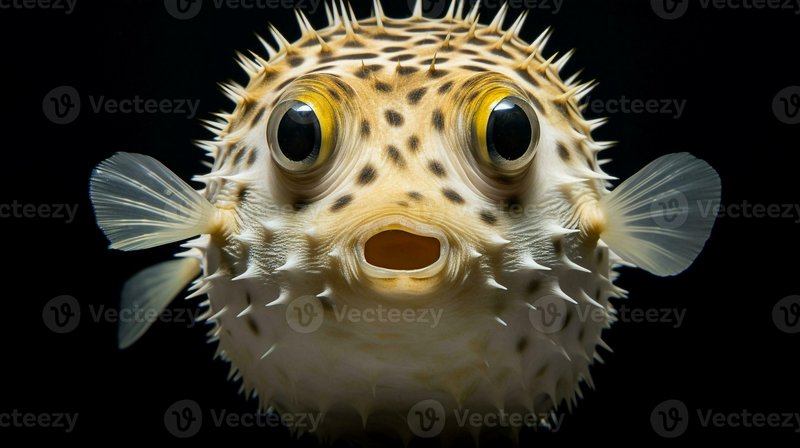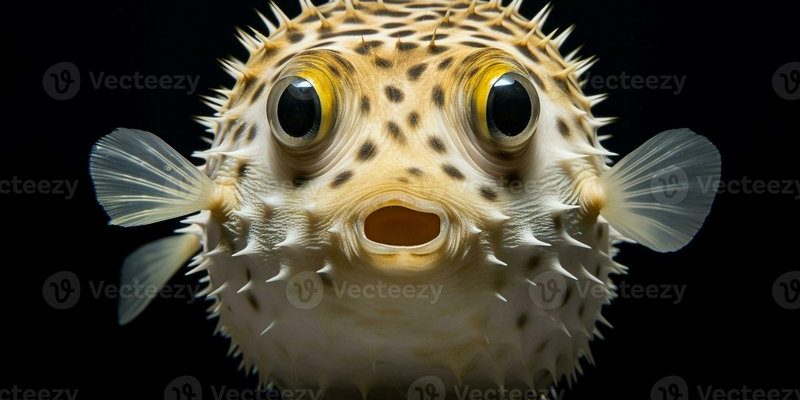
Pufferfish, also known as blowfish or fugu, are some of the most intriguing and unique marine creatures in the ocean. Imagine a fish that can inflate itself like a little balloon, becoming much larger when threatened. This fascinating ability is not just for show; it serves as a defense mechanism against predators. The pufferfish is a part of the Tetraodontidae family, which includes around 120 different species that can be found in tropical and subtropical waters around the globe.
One of the most interesting aspects of pufferfish is their fascinating biology. They can store toxins in their bodies, which makes them poisonous to predators. In fact, the toxin found in some species of pufferfish, called tetrodotoxin, is deadly to humans. Despite this risk, pufferfish are considered a delicacy in certain cultures, particularly in Japan, where skilled chefs prepare fugu using special techniques to minimize the danger of poisoning. Exploring the world of pufferfish is like diving into an underwater mystery filled with beauty, danger, and culinary curiosity.
Physical Characteristics
Pufferfish come in various shapes, sizes, and colors, making them visually striking. Generally, they have rounded bodies and small mouths, with some species showcasing vibrant hues and intricate patterns. The average size of a pufferfish can range from just a few inches to over two feet in length, depending on the specific species.
One distinctive feature of pufferfish is their ability to inflate when threatened. They have a specialized stomach that can expand, allowing them to take in water or air and swell up to several times their original size. This inflation makes them look intimidating to potential predators and is a unique survival strategy that not many fish possess. Their skin is often covered in spines, adding an extra layer of protection. When inflated, these spines protrude, creating a formidable barrier that deters attackers.
Additionally, pufferfish have unique teeth that resemble a beak, perfect for cracking open hard-shelled prey like shellfish. Their diet typically consists of a variety of marine organisms, including crustaceans, mollusks, and algae. This specialized diet, combined with their unusual adaptations, makes pufferfish a captivating subject for marine biologists and casual fish watchers alike.
Habitat and Distribution
Pufferfish predominantly inhabit warm coastal waters, particularly in the Indo-Pacific region, though some species can be found in freshwater environments. You’ll typically find them in shallow areas, like coral reefs, lagoons, and even river mouths. These environments provide the rich food sources that pufferfish need to thrive.
The distribution of pufferfish is quite diverse. From the vibrant Great Barrier Reef to the serene and murky waters of the Amazon River, these fish adapt remarkably well to their surroundings. The variety in habitat also contributes to the different visual characteristics seen in pufferfish from various regions. For instance, pufferfish in coral reefs might exhibit bright colors to blend in with the vivid marine life, while those in murkier waters are often more muted in tone.
While pufferfish are generally found in tropical and subtropical waters, some species have made their homes as far north as the coasts of Japan and as far south as the southern parts of South America. This ability to adapt to various environments makes them a resilient family of fish in our oceans.
Diet and Feeding Habits
Pufferfish are omnivorous, which means they eat a mix of plants and animals. Their diet primarily consists of small invertebrates, such as crustaceans and mollusks, alongside algae and seaweed. This variety in their diet reflects their adaptability and helps them thrive in various marine environments.
Their beak-like teeth are perfectly designed for their feeding habits, allowing them to crush hard shells effortlessly. When feeding, pufferfish often scavenge around the ocean floor, using their keen sense of smell to locate food. They can spend hours foraging, using their specialized teeth to nibble away at their favorite snacks.
Interestingly, pufferfish have an important role in their ecosystem. They help control the population of certain marine species by preying on them. Additionally, their feeding habits can aid in maintaining the overall health of coral reefs and other marine habitats. The relationship between pufferfish and their environment is a beautiful dance of survival and balance in the ocean.
Defense Mechanisms
Pufferfish possess a unique set of defense mechanisms that help them survive in the wild. The most famous is their ability to inflate into a spiky ball, which can deter many predators. But there’s more to their defense than just puffing up. Pufferfish also have a toxic side—their bodies contain tetrodotoxin, a potent neurotoxin that can cause paralysis and even death to those who ingest it.
Many fish, including potential predators, learn to avoid pufferfish after a single encounter. This natural aversion is crucial for the survival of pufferfish, as it reduces their risk of becoming a meal. The toxin is concentrated in their organs, skin, and sometimes muscle tissue, making it essential for the fish to be cautious about where they store these toxins.
You might be wondering how pufferfish manage to produce such a toxin. They consume certain types of marine bacteria and organisms, which contain the precursors for tetrodotoxin. Through their incredible physiology, pufferfish can store this toxin without harming themselves. This remarkable biological adaptation highlights the intricate connections in our marine ecosystems.
Reproduction and Lifespan
Pufferfish reproduce through a process called external fertilization, where females lay eggs in the water, and males subsequently fertilize them. Depending on the species, a female pufferfish can lay thousands of eggs at one time, which float freely in the ocean until they hatch. This process usually occurs in warmer months when conditions are favorable for the survival of the young fish.
The lifecycle of a pufferfish begins when the eggs hatch into larvae, which are planktonic and drift with ocean currents. As they grow, they develop into juvenile pufferfish, gradually taking on the distinctive features of adult pufferfish. Growth rates can vary significantly between species, influenced by environmental factors and availability of food.
In terms of lifespan, pufferfish can live for several years in the wild, with some species reaching up to 10 years or more under optimal conditions. However, their lifespan can be affected by factors such as habitat quality, predation, and availability of food. Understanding the reproduction and growth of pufferfish adds another layer of interest to these captivating creatures.
Threats and Conservation
Despite their fascinating adaptations, pufferfish face various threats in today’s world. Habitat destruction, primarily due to coastal development, pollution, and climate change, poses significant risks to their populations. Coral reefs—critical habitats for many marine life forms, including pufferfish—are rapidly declining, which affects their food sources and breeding grounds.
Overfishing is another serious issue for pufferfish. While they are highly valued in the culinary world, especially in Japan, unsustainable fishing practices can deplete their numbers. Some regulations are in place to protect certain species of pufferfish, but enforcement can be challenging, and illegal fishing still occurs in many areas.
Conservation efforts are vital to ensuring that pufferfish can continue to thrive in our oceans. These efforts may involve habitat restoration, sustainable fishing practices, and education about the importance of marine life. By raising awareness and promoting responsible behaviors, we can help protect pufferfish and the delicate ecosystems they inhabit.
Table of Interesting Facts
| Species | Pufferfish (Tetraodontidae family) |
| Size | Varies; from 2 to 24 inches |
| Habitat | Tropical and subtropical coastal waters |
| Diet | Omnivorous; feeds on invertebrates and algae |
| Lifespan | Up to 10 years or more |
| Toxin | Tetrodotoxin, highly toxic to predators and humans |
FAQ
How do pufferfish inflate?
Pufferfish inflate by taking in water or air into their elastic stomachs. When threatened, they can expand dramatically, increasing their size to deter predators. This unique ability can make them up to three times their normal size, which helps them appear larger and more intimidating.
Are all pufferfish poisonous?
Not all pufferfish are poisonous, but many species contain tetrodotoxin, making them potentially lethal if consumed. The level of toxicity varies between species and individuals. It’s crucial to properly prepare certain species, as even small amounts of toxin can be dangerous.
Can pufferfish be kept in aquariums?
Yes, pufferfish can be kept in home aquariums, but they require specific care due to their unique needs. It’s essential to provide a suitable environment, including adequate tank size, clean water, and compatible tankmates. Some species can be more aggressive, so proper research is critical before adding them to a tank.
What do pufferfish eat in captivity?
In captivity, pufferfish should be provided with a balanced diet that mimics their natural feeding habits. This can include high-quality pellets, live or frozen foods like shrimp and snails, and even some plant matter. It’s also important to monitor their health and adjust their diet as needed.
How do pufferfish defend themselves?
Pufferfish have several defense mechanisms. They can inflate to appear larger and more intimidating, and many species contain toxins that deter predators. This combination of physical and chemical defenses is effective in keeping them safe from potential threats in their environment.
Where do pufferfish live?
Pufferfish are commonly found in tropical and subtropical oceans, primarily around coral reefs and lagoons. Some species even inhabit brackish waters or freshwater environments, demonstrating their adaptability to different habitats.
Can pufferfish be deadly to humans?
Yes, some species of pufferfish contain tetrodotoxin, which is highly toxic to humans and can lead to paralysis or even death if ingested improperly. Only trained and licensed chefs should prepare fugu, the Japanese delicacy made from certain pufferfish species, to ensure safety.
How do pufferfish reproduce?
Pufferfish reproduce through external fertilization. Females lay thousands of eggs, which are then fertilized by males in the water. The larvae hatch and drift with ocean currents before developing into juvenile pufferfish. This reproductive strategy helps increase the chances of survival for the offspring.
What role do pufferfish play in their ecosystem?
Pufferfish are important to their ecosystems as they help control the populations of certain marine species by preying on them. Their feeding habits contribute to the balance within coral reefs and other habitats, highlighting their role in maintaining healthy marine environments.
Are pufferfish endangered?
While not all pufferfish species are endangered, some face threats from habitat loss and overfishing. Conservation efforts are crucial to protect these unique creatures and their habitats, ensuring they continue to thrive in the oceans.

